Scotland’s Artisans: Weaving and Fashion Design
29th November 2024
Scotland’s vibrant crafting culture is woven into its history. Fabric making was once carried out in every village and township across the country: Plenty of thick wool clothing was needed to protect Scotland’s people from the weather. Our artisan weaving and garment-making culture is a testament to centuries of craftsmanship and national identity from the iconic tartans that trace their origins to the clans of the Highlands, to the globally renowned Harris Tweed. Once a necessity, weaving has evolved into a modern art form, with contemporary artisans combining traditional techniques with innovative designs. Today, Scotland’s weavers and fashion designers continue to create exquisite textiles and garments that honour their heritage while appealing to a global audience, ensuring this age-old craft thrives in the modern era.
For a richer understanding of the craft and how the vibrant design scene in Scotland is being preserved, we thought it important to ask the source. We spoke to some of our contacts in the weaving and fashion industry to give them a platform to share a bit about what they do. Read on to find out what our favourite clothing creators had to share.
Araminta Campbell

Could you give us a short intro to who you are and what you do?
I am Araminta Birse-Stewart, the founder, creative director, and lead designer of Araminta Campbell. My work is centred around creating bespoke and limited-edition woven textiles that celebrate Scotland’s natural beauty, heritage, and craftsmanship. With a deep commitment to supporting the Scottish textile industry, I employ skilled handweavers in my Edinburgh Atelier, making Araminta Campbell the largest employer of traditional handweavers in the UK, which I am super proud of. Collaborating with artisan rural mills, I am passionate about championing both handweaving and mill weaving, preserving these time-honoured crafts is at the core of what I do. This dedication allows us to create heirloom-quality pieces while ensuring that Scotland’s rich weaving heritage remains vibrant and thriving. Each design I create is a tribute to traditional weaving, reimagined for a modern audience!
Where in Scotland are you based and what do you love about your region?
We are based just on the outskirts of Edinburgh in South Queensferry, where our stunning Atelier overlooks the Forth Road Bridges and is nestled in a beautifully leafy, rural setting. I love this location as it reminds me of my home in Aberdeenshire and offers the perfect blend of tranquillity and inspiration. Its proximity to both Edinburgh and Glasgow makes it ideal for our team and visitors, which is important! The rural surroundings fuel my creativity and joy, allowing me to draw inspiration from the natural elements surrounding me.
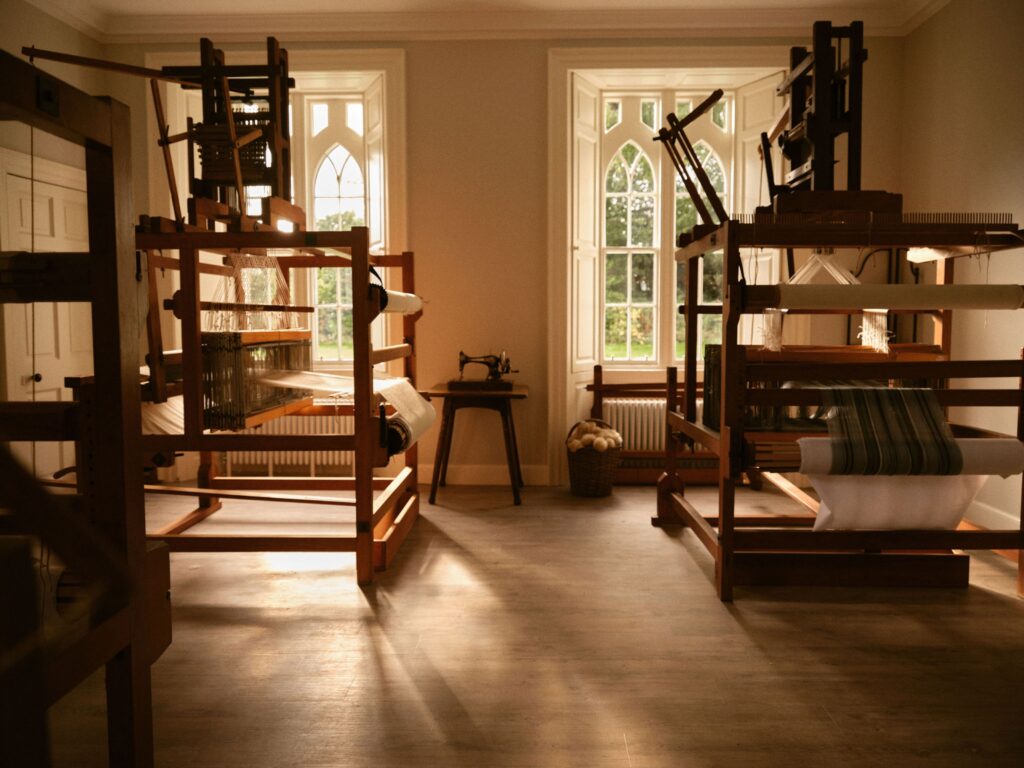
How did you first get interested in your craft?
It was a tradition that sparked my early interest in textiles, inspired by the tweed and tartan worn at special family gatherings! Growing up in Aberdeenshire, I spent much of my childhood exploring the surrounding fields and woodlands, nurturing an appreciation for Scotland’s natural beauty. I discovered the creative potential of textiles during secondary school, which led to a degree in Fine Art Embroidery from Manchester Metropolitan University. In 2011, as I neared the end of my studies, weaving captivated me, and I devoted countless hours to mastering the craft.
After graduating, I continued to explore weaving independently, pushing myself beyond traditional design boundaries. In 2014, I launched the first Araminta Campbell collection, showcasing unique artistry, storytelling through fabric, and a deep-rooted love for nature and Scotland’s heritage. These elements remain central to every piece I create now, seamlessly blending tradition with contemporary application.
What are your artistic influences or inspirations? Has Scotland and Scottish culture shaped what you do?
I don’t follow fashion trends; instead, I draw inspiration from the people and the natural landscapes around me, as well as the surroundings of my clients when designing bespoke pieces. Scottish culture and the rugged beauty of its landscapes have always profoundly influenced my work, serving as a deep well of inspiration. I am inspired not only by traditional Scottish dress but by the rich fabrics and the heritage of the Scottish textile industry, and every intricate detail of the process of taking raw fibre and turning it into something beautiful! Supporting those who work within the textile industry, promoting its legacy on an international stage, and making its craftsmanship accessible to the world are at the heart of what I do.
What do you love most about your craft?
What I love most about my craft is witnessing the transformation of raw fibre into something truly exquisite, each piece we create is embellished with its very own story which I absolutely love. There is something truly special about seeing a design evolve from its inception to its completion, with every step infused with care and creativity. The moment when raw fibre becomes a wearable piece of art is pure magic, whether brought to life by the skilled hands of our handweavers in the Atelier or through the expert craftsmanship in rural mills. It’s an extraordinary process that never ceases to inspire me.
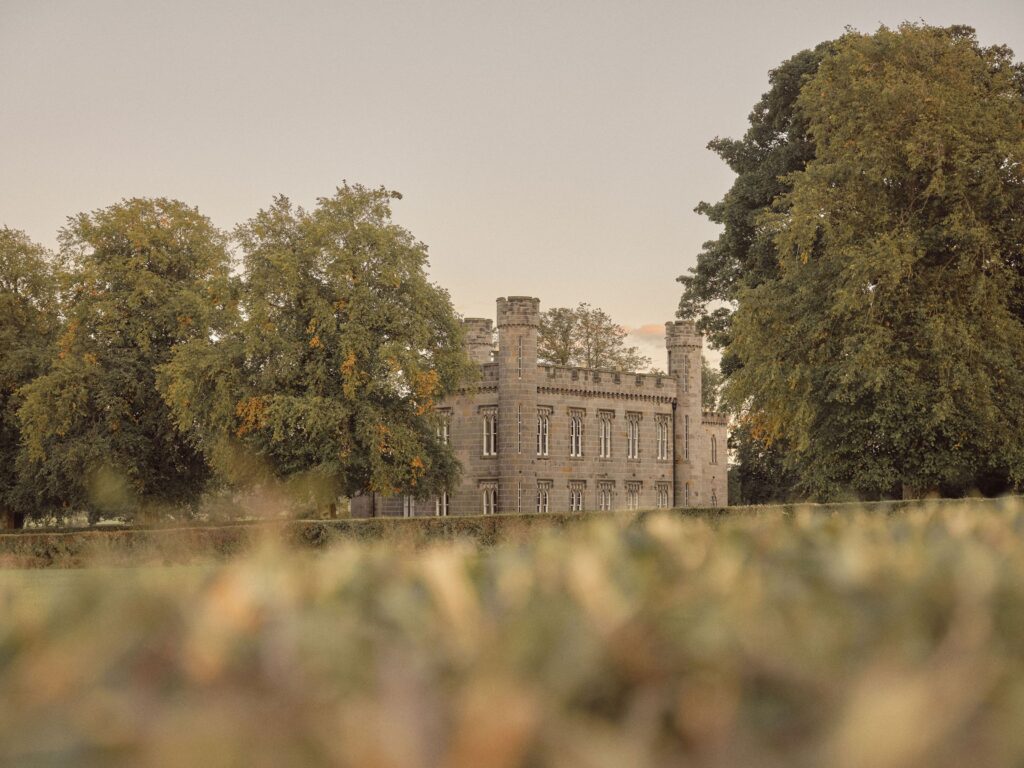
What unique experience would you recommend to visitors to Scotland?
I wholeheartedly recommend a visit to our castle-like Atelier, a truly authentic Scottish experience that is hard to come by and something I am incredibly proud of! It is rare to have the opportunity to witness the intricate artistry of a traditional weave workshop first hand. At our Atelier, you can also meet our talented artisans, observe their craftsmanship up close, and hear their personal stories of dedication and mastery in their craft; which makes this experience truly unique. Nestled in a stunning location, our Atelier not only showcases the beauty of our work but also embodies our pride in contributing to the wider textile industry.
Are there any other craft makers in Scotland who you recommend?
I highly recommend a visit to Bard, a truly one-of-a-kind space that showcases the incredible talents of over 60 Scottish artisans. This unique shop and gallery, located in Leith, Edinburgh, is the only store I know of that exclusively represents Scottish craft. Their mission is to elevate our daily experience through craft while making Scottish design accessible to a global audience, which is something that aligns perfectly with my own mission! While you’re there, be sure to explore the stunning work of Iseabal Hendry, one of the featured artisans and a dear friend of ours. Born and raised in the Scottish Highlands, Iseabal draws inspiration from traditional crafts such as basket-weaving and clinker-boatbuilding. Using natural materials like vegetable-tanned leather, locally sourced wood, and foraged plants, her creations reflect a profound sense of place that beautifully embodies the essence of Scottish craftsmanship.
Sandra Murray
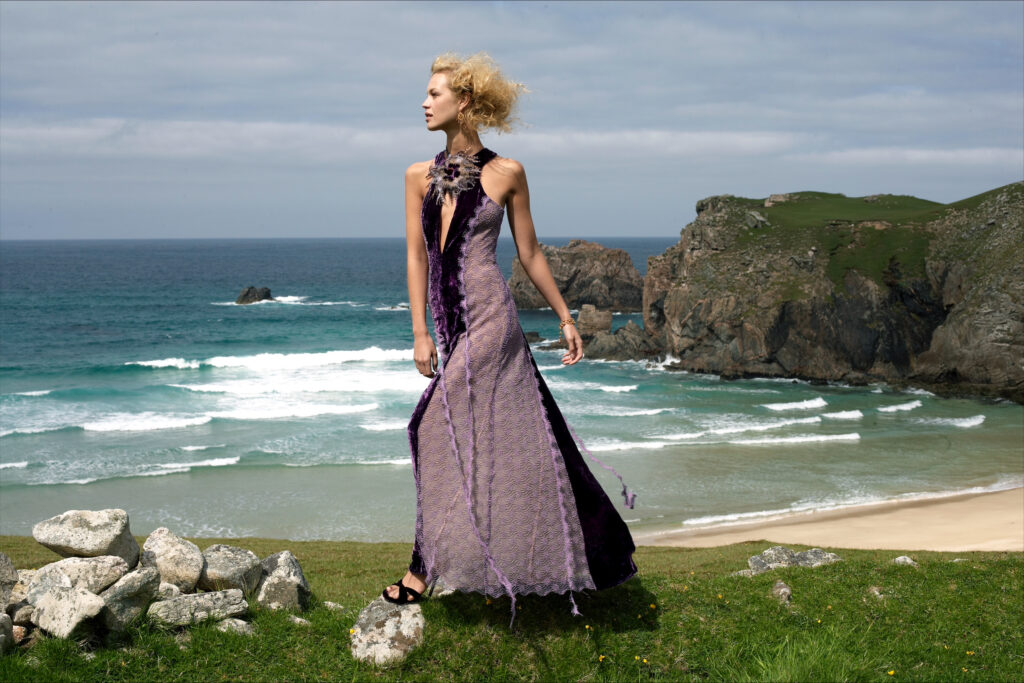
Could you give us a short intro to who you are and what you do?
I’m an Artist-Couturier of Bespoke. I create unique artisanal pieces in exceptional materials, combining Scottish heritage tartans, Harris Tweed and other top-of-the-range textiles, with haute couture French lace and Italian silks. Each piece is not just inspired by Scotland, I am a born and bred Hebridean, a native Gaelic speaker, which I believe gives the work a distinct spirit of place and its stamp of authenticity.
Where in Scotland are you based and what do you love about your region?
I have been based in Inverness in the Highlands, since 1976, beginning with a career as an art teacher. The art of the needle and a passion for textiles gradually replaced teaching, and I became an Artist first, and an entrepreneur second.
Living in the Highlands was a lifestyle choice, as my husband worked locally in Raigmore Hospital. Many of my creative interests admittedly are city-based and not in Inverness, essentially needing to visit galleries and major exhibitions, which in turn become inspirational. For me, first and foremost, the Highlands connects me to my roots.
In 2005, when I decided to change artistic direction, I realised that my sense of colour, tone and texture reflected the environment around me each day and was not purely the result of studying painting at Glasgow School of Art. I decided that my heritage should be the major influence on my Hebridean Collection, and become the house signature.
How did you first get interested in your craft?
From the age of 12, I desired to make my own skirts. From half a yard, (18”) I could create a 60’s mini skirt, with skills learnt in school, and after that, became my own apprentice. I curiously and closely examined clothing, inside and out, in shops high and low end, between Inverness and Paris to learn their tricks. True passion is what is required if you wish to learn something. Fast forward, I visited Premier Vision salon in 1991 to source high-end fabrics, then travelled there and to Italy to build my cloth archive.
My mum had a cottage-type business making oiled Harris wool sweaters, and trading internationally, pre-internet. My Dad, while he was teaching in Lewis Castle, his first love was boatbuilding. He built a sailing ship for a BBC documentary, so I guess craftsmanship, is in my genes.

What are your artistic influences or inspirations? Has Scotland and Scottish culture shaped what you do?
Over the years, I have had two separate streams of influence. My interest in Art/ Artists in the wider sense and the other, closely watching what was happening in the fashion arena. Vuillard and Bonnard have been my longstanding painter icons. Chagall and surrealism and many more are on my list. In fashion, I always admired Schiaparelli, then Christian Lacroix, John Paul Gaultier, and now John Galliano has my full admiration. I love haute couture and the meticulous craftsmanship with embroidery it represents. I see that I have a wider appreciation of the more avant-garde, as my own career evolved, with Japanese Rei Kawakubo, always offering intrigue.
I love uniqueness. If you have something, I don’t want it. RTW works on the principle of everyone having the same thing. This is why the world of Bespoke fits into my personal philosophy. Have less, but be of the best. My brand hasn’t been structured on commerce. It is now, all about the product and concentrates on its continued refinement.
I feel privileged to have artistic freedom to be doing what I’m doing, where I’m doing it. I was fortunate to have learnt the craft of garment construction. This is what costume designer Sandy Powell recommended to fashion students because many designers can’t or don’t sew. It has allowed me to have my own sole practice in the Highlands, below and away from the high-end fashion radar, but still sell to an international clientele. It was remarkable in my own experience, that the late Queen Elizabeth II, commissioned me to make her ensemble for the Opening of the Scottish Parliament, in 1999. News travels.
What do you love most about your craft?
The Highlands and Islands offer an extraordinary experience in regard to scenery, regardless of weather patterns. I travelled along the very north coast recently and the unexpected pink rock face colours were breathtaking, as the road undulates from Durness to Tongue. It’s a living painter’s palette. It’s not a surprise that Danish ceramist Artist Lotti Glob has made it her base for the last 40 years and the source of inspiration.
What unique experience would you recommend to visitors to Scotland?
Visiting Scotland’s castles is a worthwhile experience. Scottish food is very high on my experience radar and the freshly caught just boiled and served still warm langoustines, with a little mayo, is sublime. As is the west coast fresh crab. Coincidentally, my brother’s restaurant in Glasgow is called Crabshakk!
Skye Weavers
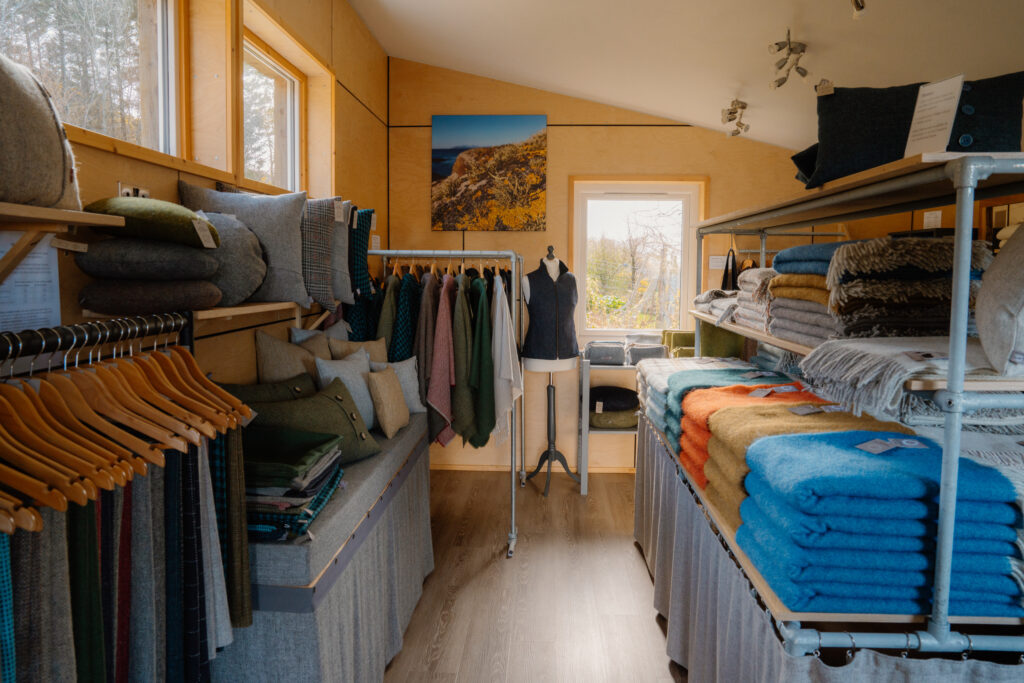
Could you give us a short intro to who you are and what you do?
We are a small weaving and sewing business on the Isle of Skye. We design and create tweed, textiles, homewares and clothing in natural woollen yarns. Everything is designed and woven by us on our two bicycle pedal-powered looms, and we source much of our wool locally. We welcome visitors to our weaving shed and small shop and also have an online store.
Where in Scotland are you based and what do you love about your region?
We live and work in a small croft in Glendale, north-west Skye. The island is famous for its dramatic scenery of course, and we feel very privileged to live in such a stunning location. We’re both passionate about the outdoors and when we’re not weaving we love walking, cycling and swimming – there’s such a wide variety of landscapes to explore. It’s a cliche perhaps but one of the most magical aspects is the ever-changing light – you can see why so many artists make Skye their home. But perhaps most of all we really appreciate being part of such a warm and welcoming community. It is very special to be working closely with local farmers and crofters, producing something that is tied so closely to the land we share.
How did you first get interested in your craft?
We actually met while we were both working on an organic farm on the isle of Mull. The owners kept Hebridean sheep and used the wool to weave tweeds, blankets and scarves at the weaving mill on the farm. We were fascinated by the whole process and when the opportunity arose to weave ourselves on a bicycle pedal-powered loom, we jumped at it. In 2012 we took the decision to move to Roger’s old family croft house in Skye and start our own weaving business. And we haven’t looked back!

What are your artistic influences or inspirations? Has Scotland and Scottish culture shaped what you do?
Our island home is a key source of inspiration for our weaves. But despite all the big dramatic landscapes around us we often find our inspiration in the small things around us: lichens, mosses, grasses, rocks, bark or leaves. The small things allow you to get close and observe patterns and textures. Sometimes we use particular colour combinations we see in the weaving, sometimes it’s the patterns and textures. We spend a lot of time looking at things, making sketches and thinking about possibilities while we’re pedalling away on the loom. The mere act of pedalling seems to create a stream of ideas. Weaving and tweed are age-old Scottish traditions, so in that respect, we are steeped in Scottish culture. Scotland has a proud history of high-quality textile-making, but sadly much production has now moved overseas. We feel strongly about the need to preserve the knowledge and quality associated with Scottish tweeds and garments. But at the same time, we want to develop these traditions in new ways. So although we use traditional techniques and equipment – our looms are the type also used by Harris Tweed weavers – we push them in new directions weaving a range of different patterns and products as well as lengths of more traditional tweed.
What do you love most about your craft?
We really love working with wool – it’s a natural fibre and 100% renewable as sheep grow it every year! It keeps you warm and cosy, and at the end of its life, it’s biodegradable. It’s also such a versatile fabric – we love creating everything from supersoft lambswool baby blankets to super-thick blankets and warm tweeds. And while we love working with all types of wool, we particularly love working with local Skye Wool. It gives us great satisfaction to use this natural and local resource and to know exactly where our wool comes from. Anyone who comes to see us in Glendale will meet some of our Skye Wool suppliers grazing along the road! For these items we are involved right from the start – we are there at the sheep clipping (shearing), selecting and grading the wool then sending it to be spun into a yarn in a range of natural shades giving us a lot of pattern possibilities already before we get anything dyed. Another element that is particularly satisfying is to be as low-impact and sustainable as possible. Lots of our mill equipment is recycled and repurposed – we made our own warping mill from the wheels of a derelict tractor for instance. We work hard to minimise the environmental impact of everything we do, and for any outside suppliers (e.g. dyers and finishers) work exclusively with long-established British firms.

What unique experience would you recommend to visitors to Scotland?
That’s a difficult one as it depends so much on individual tastes, but the one thing we would say is to take it slowly and try not to spread yourself too thinly – concentrate on experiences rather than ticking ‘must-see sights’ off a list. Don’t plan on seeing Scotland in 3 days! And don’t get too hung up about the weather – every season has its charms, and we particularly love the winter with its special low light, crisp days and cosy evenings. Just come prepared for a bit of everything.
Are there any other craft makers in Scotland who you recommend?
That’s another difficult one! There are a host of excellent makers in Skye and the Highlands and we’d hate to single out some and leave out others. We’re part of the Skye & Lochalsh Arts & Crafts Association, who produce a useful guide and online map of local makers and artists so if you’re planning a trip to Skye do have a look. Many of them, like us, are open to the public in the season and it’s a great opportunity to meet the makers and support local crafts.
Weaver’s Cottage – National Trust for Scotland

Could you give us a short intro to who you are and what you do?
We are Susanne and Abigail and are both Visitor Guides at the wonderful, 300-year-old Weaver’s Cottage in Kilbarchan which is owned by the National Trust for Scotland.
Where in Scotland are you based and what do you love about your region?
We are based in the picturesque, historical village of Kilbarchan. Kilbarchan is one of several pretty villages to the west of Glasgow near the river Clyde. Our region is very indicative of living in lowland Scotland but there is easy access to Argyll and other beautiful areas.

How did you first get interested in your craft?
We both love weaving, textiles and the history of both. We’ve developed our skill sets working in the Cottage, YouTube, working on our own looms and more importantly bouncing ideas and knowledge off each other.
What are your artistic influences or inspirations?
We love Tartan both prior to the Proscription Act and thereafter. The influences of tartan are to be found in our dramatic landscapes, the mountains, the lochs and the wildlife.
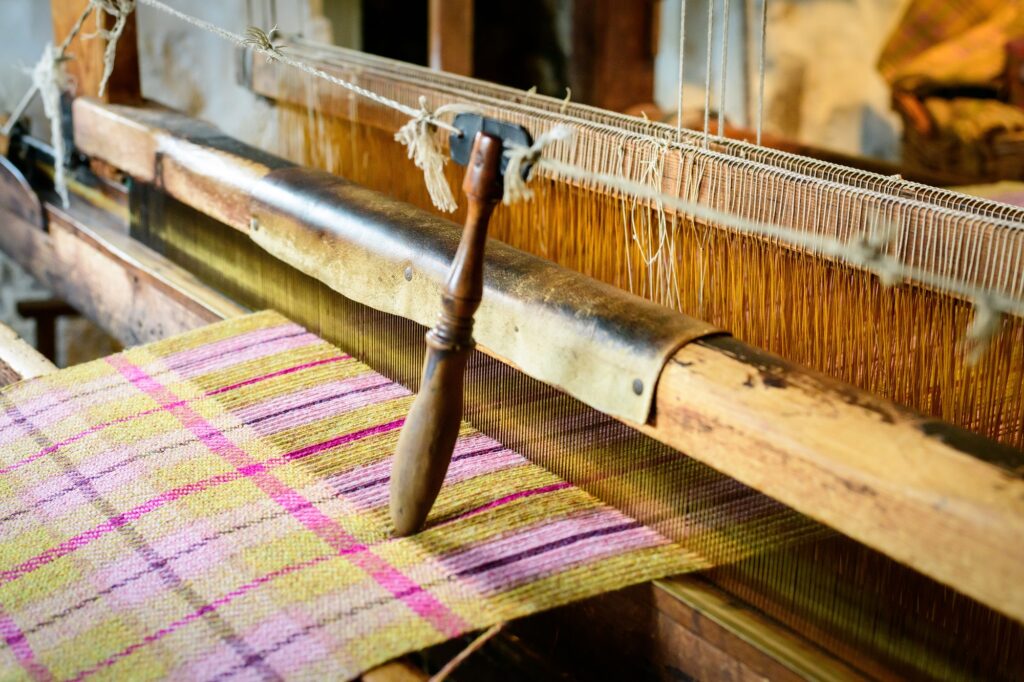
What do you love most about your craft?
We both love to develop our crafts to fit in with the modern lifestyle whilst retaining the influences of our forebears. We would also like to see retrograde steps towards a more environmentally friendly use of dyes and yarn.
What unique experience would you recommend to visitors to Scotland?
Come to Weaver’s Cottage and you will be immersed in pre-industrial life where we teach you to weave. Our enthusiasm knows no bounds.
Are there any other craft makers in Scotland who you recommend?
Susanne is Clerk to the Incorporation of Weavers in the Trades Hall in Glasgow based in the most amazing Robert Adam building. There are 14 incorporated Crafts of which the Weavers is over 500 years old. Susanne has a great knowledge of the Trades Hall and its history and has contacts in many other Crafts. Abigail has designed and made her own Tartans one of which is registered with the Scottish Tartan Authority.
We would like to thank all of our wonderful interviewees for their captivating insight into their weaving and fashion design. We regularly have clients visit the artisans in this article to see them at work and gain deeper insight into the history and modern-day atmosphere. At Away from the Ordinary, we cater to every one of our client’s unique interests and desires. Get in touch today to start planning your bespoke trip to Scotland.
Read more like this: